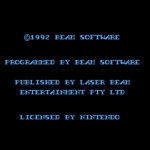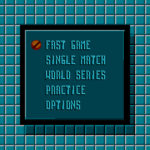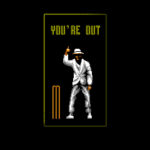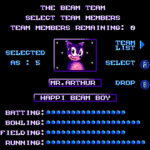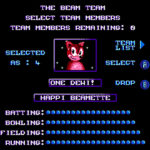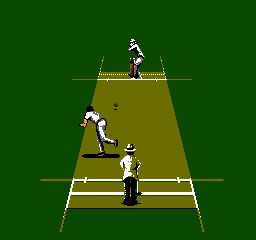
Released in 1992, International Cricket is the second of the Australian Sports Games Beam Software self published in Australia for the Nintendo Entertainment System (NES ) through their publishing arm Laser Beam Entertainment. It followed on from Aussie Rules Footy in 1991.
International Cricket is a sport simulation of one day cricket. It offers a single match mode for one or two players. Whilst World Series mode supports one, two, three or four players featuring teams competing in a round robin format. World Series modes’ structure was similar to the popular Benson and Hedges World Series that was hosted in Australia from 1979 till 1996.(1)
There are eight featured teams: Australia, England, India, New Zealand, Pakistan, South Africa, Sri Lanka and West Indies. The names of the Australian team parody those of cricketers or the era without actually using real names. For example A. Boulder (Allan Border), G. Swamp (Geoff Marsh) J.Dean (Dean Jones) and H. Mervyn (Merv Hughes). The game was not licenced by the Australian Cricket Board.
Players of International Cricket needed to master the controls for batting, bowling and fielding. Bowling allows the player to control the length of the bowl and a choice of off-or-near-stump (left or right of the batter). The speed and spin of the bowl is set by the statistics of the selected cricketer. Batsman combine options for blocking, hooking, square cut and straight cut with choice of ground or air shots and directional control. Fielding is the most problematic interface and the player can find themselves wrestling for control of the sluggish fielders with the game AI. Automatic fielding can be turned off in game options leaving the player in sole command of the fielders lumbering antics. Whilst not the most graceful set of controls gamers of the era recall that the games was not difficult for a cricket fan to grasp. Its AI was however quite simple making it easy for players to exploit it for an easy win. Review and recollections all advocate for a player-on-player match for a better game.
In his RetroGamingAustralia Let’s Play, Mat Keller observes that as far as rules of the game go there are differences between cheating at cricket and cheating in the videogame, and by manipulating the games AI players can to take certain liberties with the sport. (see videos linked below).
The game starts with a coin toss to see who bats. The loser of the toss must then place their team on the field. The camera is at 3rd person for the batting and bowling switching to a birds-eye view when the ball is hit. The gameplay features a variety of cutscenes to celebrate play including “Out for a Duck”, “Bowled” and the classic “Howzat”. These are nicely executed as Beam had developed their own in-house systems to produce quality audio and animation for the NES. As it is cricket, the game features the necessary assortment of screens providing player and game statistics. Final victory, however, is celebrated with a modest “congratulations” screen rather than a litany of data and reports.
There are a number of cheat codes and easter eggs in the game. A 9th team, the Beam Team can be unlocked to reveal a full team of Beam staff all pictured as Sonic the Hedgehog the nemesis of Nintendo. In a bold move for World Series Cricket in the 1990s the Beam Team includes female players. Hidden in the game is also a secret message celebrating another women at Beam stating “Sue Anderson: A Guru for the Ninties” (sic) Sue Anderson was a producer at Beam in the 1990s working on NES and SNES titles. Others cheats include the capacity to play all the in game music samples and for the bowler to throw an uncatchable ball.(2)
(1) After 1996 laws governing the advertising of tabacco in Australia saw the series change its name to the Carlton and United Series.
(2) Thank you to Rey for sharing images of the Beam Team. Cheat codes shared by him can be found at GameFaqs
Version Information
In 1994 Beam Software released Super International Cricket an updated 16bit version of International Cricket for the Super Nintendo Entertainment System (SNES). Whilst the gameplay was structurally very similar, the SNES game featured far superior AI, offered easier and more defined controls, improved animations and included graphic cinema sequences and voice samples. It also addressed some issues that had annoyed players of International Cricket such as the tiny pitch with its the retina burning green saturation offering a larger field and a softer green. Super International Cricket was published by Nintendo and received international distribution.
International Cricket was only available in Australia. In the late 1990s Indian Company Mitashi did publish an 8bit cricket game also called International Cricket for their Mitashi TV Game System which was a Famiclon (Licenced clone of the Nintendo Famicom). But this version of International Cricket appears to be based on the UK company Audiogenic (Codemasters) 1994 game Brain Lara Cricket. (1)
(1) Thank you to Joshua Rogers for his advice on Mitashi International Cricket – personal email correspondence and forum
Game Meta
Other Names
Genre
Additional Creators
Screenshots
- Beam SoftwareCredit Screen
- Title Screen
- Select Match Type
- Match Announcement
- Bowling / Batting Perspective
- Howzat!!!
- Fielding
- Umpire – “Four”
- “Out for a Duck” 1
- “Out for a Duck” 2
- Fielding
- Howzat!!
- Umpire – “You’re Out”
- Match Conditions
- Bowling / Battling
- Fielding
- Howzat!!
Box Art
- Box Art – Front
- Box Art – Back
- NES Cartridge – Front
- NES Cartridge – Back
Media
Easter Egg – The Beam Team as Sonic the Hedgehog
- Beam vs New Zealand
- Select Players – Beam Team
- Jeff the Designer and Programmer
- Darren – Design & Programming
- Chris – Ruckman
- Brain – Design & Programming
- Paul Mitchell (Graphics and Paul Davie
- Ian – Happi Beam Boy
- Justin – Happi Beam Boy
- Ann – Happi Beamette
- Trevor – Happi Beam Boy
- Fishin Rod – Happi Beam Boy
- Mr Arthur – Happi Beam Boy
- One Dewi – Happi Beamette
- Many Andys – Plural Beamers
- Some Davies – Plural Beamers
- The Shane – Happi Beam Boy
Manuals & Walkthroughs
Video

